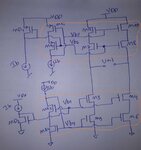Junus2012
Advanced Member level 5

- Joined
- Jan 9, 2012
- Messages
- 1,552
- Helped
- 47
- Reputation
- 98
- Reaction score
- 53
- Trophy points
- 1,328
- Location
- Italy
- Activity points
- 15,235
Hello,
Following my formal post, I am trying to bias the core amplifier by means of biasing current mirror like shown in the image below

As you see, Mx1-Mx4 are the bising mirror to the core amplifier (folded stage),
To save power, I am trying to make Ib less than the needed current in the amplifier then I rise it by means of the mirror ratio, for example I choose mirror ratio of 4,
My question, is it possible to increase the mirror ratio like to make it 10 ? I read somewhere that as more we increase the mirror ratio as more we have less aqurate mirror, is that true ? what is the preferable or reasonable ratio you would suggest
thank you very much
Following my formal post, I am trying to bias the core amplifier by means of biasing current mirror like shown in the image below

As you see, Mx1-Mx4 are the bising mirror to the core amplifier (folded stage),
To save power, I am trying to make Ib less than the needed current in the amplifier then I rise it by means of the mirror ratio, for example I choose mirror ratio of 4,
My question, is it possible to increase the mirror ratio like to make it 10 ? I read somewhere that as more we increase the mirror ratio as more we have less aqurate mirror, is that true ? what is the preferable or reasonable ratio you would suggest
thank you very much




